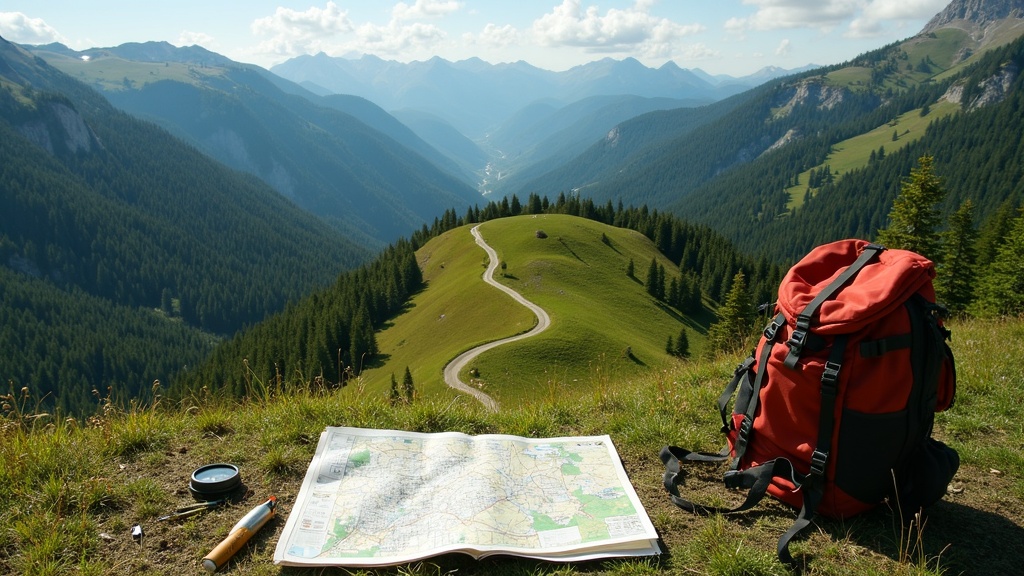Getting ready for a hike is one of those things that feels simple until you start looking at all the little details. Routes, weather, kit, snacks, and the difference between a quick local hill and a days-long trek through wild places all play a role. Careful planning is what helps a walk turn into a great memory rather than a stressful slog. Here, I’ve gathered some handy tips, tricks, and basic advice I always keep in mind when setting out, whether it’s for a half-day stroll in the Ochils, or a proper adventure in the Cairngorms.
Picking Your Route: Where to Start
Choosing the right hiking route can set the tone for the whole day. There’s a surprising amount to weigh up, and even small differences in terrain, weather, or trail length can change the challenge quite a bit.
First, I always check for three things: distance, elevation, and the kind of terrain I’ll be hiking on. A 10km walk over easy paths is a totally different day out compared to 10km of boggy moorland or uneven scrambles up loose rock. Most walking apps and guidebooks give a difficulty rating, but I find reading recent trip reports or online forums from other hikers is even more helpful; these often mention overgrown sections, dodgy stream crossings, or unclear waymarks that printed guides miss.
Access rights are super important too, especially if you’re hiking in places like Scotland, where the “right to roam” lets you cross most land, but certain areas can still have restrictions during lambing season or stalking season. National parks sometimes close paths for wildlife or repairs, so I always doublecheck with local authority websites before heading out.
The time of year can make a huge difference, even on familiar trails. In summer, you get long daylight hours and drier conditions. In winter the same route could include icy patches or streams in spate. I like to check sunrise and sunset times, especially in autumn and early spring, so I’m not caught out finishing the walk in the dark by accident.
Weather & Seasonal Planning
UK weather is famous for being a bit of a wild card. Even if the sun’s out in the morning, conditions can flip pretty quickly, especially in hilly or mountainous areas. Before any hike, I always check the latest forecast, not just for temperature and rain but also wind speed and, if I’m heading up high, wind chill and visibility.
The Mountain Weather Information Service (MWIS) is one of my favourite tools for this. It gives practical details like how wet gear will get in the drizzle, how strong the wind will feel on ridges, and how low the cloud base might sit. It’s worth packing for all possibilities, even if the forecast looks okay. I keep a waterproof jacket and an extra midlayer in my backpack just in case. Being damp and cold halfway round is no fun.
If you’re new to hiking in different seasons, it’s good to know that the best times for walking vary around the UK. Spring and early summer are brilliant for wildflowers and longer days. Late autumn and winter hikes feel peaceful, though shorter daylight and muddy paths mean planning becomes even more important. I tend to avoid high ground during storms or heavy snow, but if you’re up for a challenge, just be sure your kit and fitness match the conditions.
Beyond just checking the weather, I sometimes bring a lightweight emergency bivvy or bothy bag, especially if mountain conditions could change fast. This gives extra security on longer or more remote walks, and it doesn’t weigh much.
Day Hikes vs. Multi-Day Treks: Planning and Kit
There’s a pretty big gap between packing for a quick day walk and getting ready for a multiday trek. On a day hike, I usually bring just enough food, water, and some spare clothing. For a longer adventure, the list gets bigger; overnight kit, a better map, extra snacks, a stove if you want hot food, and a way to keep everything dry.
If you’re going overnight, saving a bit of weight makes a huge difference. My top tips are to choose lightweight tents, roll up a small sleeping mat instead of a bulky one, and share bigger items like cook kits with others if you’re part of a group. For short summer trips, I’ve sometimes even swapped a heavy stove for a simple cold soak jar and stuck to easy-to-carry meals.
Thinking about where you’ll sleep is really important. Some people love wild camping, tucked away in a quiet spot far from crowds. In the UK, wild camping is unofficially tolerated in parts of Scotland and a few other spots if you leave no trace, but always check local rules. Campsites, both basic and fancier ones, can be worth every penny for a hot shower at the end of a tough day. Both need a different approach to packing and planning.
Energy, hydration, and rest breaks are easy to overlook when you’re excited about covering miles. I always plan to stop regularly; five minutes every hour for a drink and snack keeps my legs much fresher than just one long break at halfway. For longer treks, I’ll bring an electrolyte powder to add to my water, especially on hot days when you can sweat a lot more than you think. If your route goes through remote areas, check ahead for water sources. Carrying a small filter or purification tabs makes it easy to refill along the way without carrying loads of extra water.
Solo Hiking or Group Hiking: What to Keep in Mind
Hiking on your own and walking as part of a group are different experiences, and both have their own perks and pitfalls.
For solo hikes, I really enjoy the freedom to set my own pace and choose the route on the fly. That said, having no backup if things go wrong means I’m extra careful with my planning. Leave details of your route and expected return time with someone you trust, and don’t forget to check in, especially if you finish early or make a lastminute change.
Staying safe as a solo hiker means carrying a bit more gear; things like a personal locator beacon or a phone with GPS tracking on. I also save digital maps for offline use in case the signal drops. Apps like OS Maps or AllTrails have features where contacts can follow your progress, which is pretty handy.
Group hikes can be a lot more social, and problems like a twisted ankle or mapreading mistakes are usually easier to sort with others. However, groups might move a bit slower or need to adjust the pace to the slowest member, so factor in some extra time. It also helps to agree on meeting points or regroup spots in advance, so if anyone does get separated, you’re not left wandering in circles looking for each other. Good group communication helps make sure everyone is having a good time and stays confident on the trail.
- Safety basics for everyone: Carry a whistle, a map, and a way to stay dry and warm. If you’re hiking in remote or wild areas, a small first aid kit and a power bank for your phone are both super useful.
Common Challenges While Planning a Hike
It’s not always plain sailing when you’re preparing for a hike, especially if you’re trying new regions or types of trail. Here are a few things I’ve learned to watch for over time:
- Overestimating ability: It’s easy to feel ambitious at home, but tired legs or unexpected terrain can really slow you down. I always choose a route a bit below my toughest capability, especially if the weather isn’t settled.
- Nav skills matter: Digital maps are great, but a paper backup and knowing how to use a compass can save your bacon if batteries die or technology glitches.
- Logistics headaches: Routes that start and finish in different places might need a car shuffle or a handy public transport timetable. I plan these details the day before to avoid lastminute stress.
- Blisters and injuries: Having a small blister kit; plasters, tape, and some spare dry socks; has saved me more times than I can count.
- Food and water: Not all trails have streams or shops nearby. I always carry a bit extra food and water than I think I’ll need, especially on unfamiliar routes.
Keeping Flexible
You can plan every detail, but sometimes things will still change. Someone’s feeling tired, the weather turns, or a bridge is closed. I’ve found it’s much less stressful to have a backup plan in mind; a shortcut to finish early, or a nearby alternative route; than to push on and hope for the best.
Frequently Asked Questions about Planning a Hike
How do I pick a good hiking route if I’m a beginner?
Answer: Start with short, well-marked trails. National Trust sites or local parks usually have plenty of info online. As you get more confident, try gradually longer or hillier routes, and always check recent reports for updates.
Is it okay to hike alone for my first hike?
Answer: It’s totally possible, but consider inviting a friend or joining a group if you’re new. If you’re keen to go solo, stick to popular, waymarked trails at first and tell someone where you’re going.
What gear is really necessary?
Answer: Comfortable footwear, weather-appropriate clothing (including a spare layer), food, water, a map, and a charged phone are the basics. Build your kit as you learn what you use most often on each walk.
How do I plan for bad weather?
Answer: Check reliable forecasts the day before and on the morning of your hike. If conditions look rough, it’s worth delaying or changing your route. Waterproofs, an extra warm layer, and knowing where you can shelter really help.
Wrapping Up
Smart planning removes a lot of hassle from hiking and gives you the best shot at enjoying the day, rain or shine. It’s all about balancing excitement with a bit of prep. Checking your route, keeping an eye on the forecast, and packing a few extras, just in case, all make a difference. Whether you’re heading out solo or in a group, these steps help make sure your hike is one you’ll actually want to repeat. If you take the time up front to map out the details and think about what challenges might pop up, you’ll be far more likely to make awesome memories and stay safe in the wild.


Leave a Reply